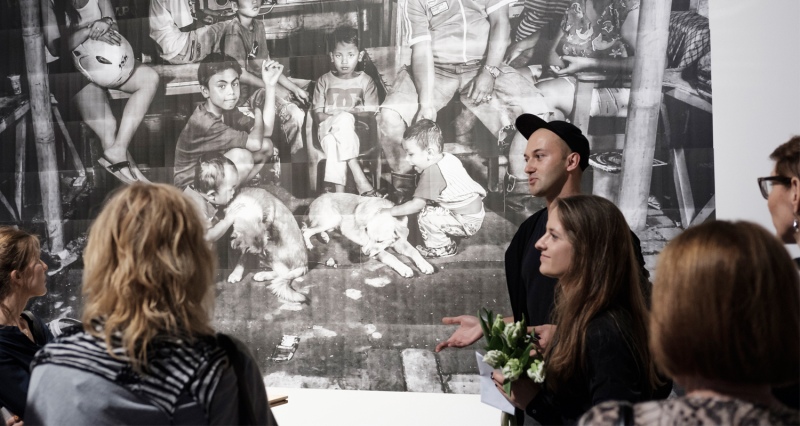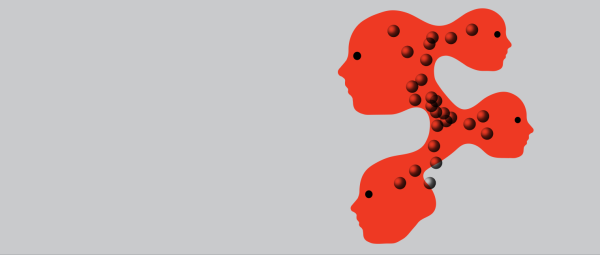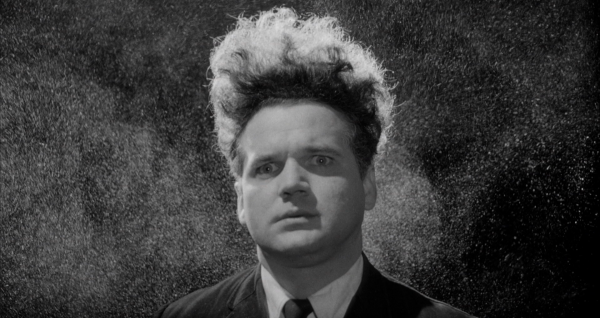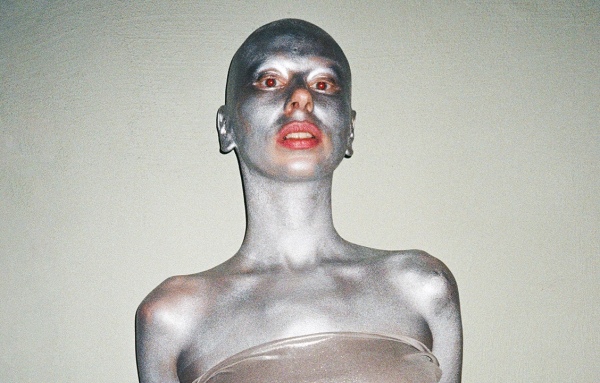An interview with Marianna Dobkowska and Krzysztof Łukomski
curators of the Gotong Royong. Things we do together exhibition
-
We are meeting in a very unusual, though familiar, space. This is an exhibition at the Ujazdowski Castle, although I have an impression that I came to a workshop that has just ended.
- Krzysztof Łukomski: – This exhibition is designed this way, so that a visitor can not only watch the objects presented here, but also grab them, sit on the floor, lay on a circular blanket – a proposal of interim meeting architecture by the Centrala Design Group – or rearrange furniture for their purpose – shift a table or a bench to make it more convenient for them to, for example, embroider their shirt or read selected texts.
-
Embroider their shirt?
- Marianna Dobkowska: – We have just finished a workshop led by Małgorzata Markiewicz, Joanna Rajkowska and Alicja Wysocka where participants embroidered several shirts and ties with inscriptions – letters to men of the Mathare slum in Kenya. They are husbands of women working in the Cooperative Spółdzielnia Ushirika, established in Nairobi in cooperation with Alicja Wysocka. One of the shirts was even embroidered by a lady who tends to the exhibition halls every day. Gotong Royong. Things we do together is not a typical gallery project. We called it an exhibition-meeting, because the most important things happen here during meetings, when all participants can get something, but also make a contribution. It works at the level of meetings, conversations, workshops for adults and children, performative activities, but also just fun. We focus on building relationships and this space is designed to encourage it.
-
How was your project born, how long did you develop it?
- Marianna Dobkowska: – The concept was developed in different contexts and different moments. It is a result of our trips, meetings and study visits over the past few years. One of the most important activities undertaken by me and Krzysztof was a two-year project “Social Design for Social Living", conducted in cooperation with Indonesian collectives and Polish artists and summarised with an exhibition at the National Gallery in Jakarta. The activity of Jatiwangi Art Factory, our colleagues for a few years, dates back to 2007. Then, a group of artists in a small town on Java began to create their own language of contemporary art, detached from the official interpretation, based on activities that are deeply rooted in local history and tradition. Indonesia, generally, is a seedbed of artistic collectives, and some of them take part in the exhibition. We also present many-year-long experience of artists, activists, and researchers who appeared at the Ujazdowski Castle as participants of the residency program. We closely observed their practices and found them to be close to what we wanted to show here, that is the relationship between art, building community and acting on a common task.
-
The gotong royong term comes from Indonesia and actually means “common task”, but also things we do together. What can the Indonesian way of acting have in common with the Central Europe culture?
- Krzysztof Łukomski: – In fact, our exhibition is often perceived as an “Indonesian project” or an “exhibition of Indonesian contemporary art”. But we just used an Indonesian term to pay homage to the practices that turned out to be similar to each other - discovered by us in different parts of the world as a result of our interests. Also, and probably first of all, in Poland.
-
Is there a common denominator?
- Krzysztof Łukomski: – Differences are as important as similarities here. But indeed, we looked for these relationships and similarities, and even arranged the exhibition to confront such projects as the long-time activity of the artistic-activist group led by Jaśmina Wójcik in Ursus with the activity of the Jatiwangi Art Factory collective from West Java - by placing them in one room. Artists from Java work in a difficult environment of socio-economic change; literally, between a rice field and roof tile workshops, which local activists must defend against predatory market transformation and conversion of traditional local workplaces into global corporations’ factories. Here, the common denominator is the post-industrialisation and an action of community against marginalisation, exclusion, gentrification and pseudomodernisation.
- Marianna Dobkowska: – Definitely, such a denominator is acting for the common good, using competences from various fields and introducing the so-called gift economy. It is the opposite of the capitalist approach, where you have to produce a product, and then sell it dearly or buy it cheaply. A gift is something selfless, it is transferred to be used.
-
We will come back to the gift economy, now tell us about these two geographically distant but similar examples.
- Marianna Dobkowska: – Both projects deal with identity, memory, local heritage and refer to the work ethos. As such, the activities of the Jatiwanga Art Factory collective aim to build a new identity and culture based on the tradition and ceramics that constitute the livelihood of Jatisura commune, where they work. Whereas the Ursus Plant Project is designed to preserve the memory of life and work of the community of the tractor factory former employees.
- Krzysztof Łukomski: – The Jatiwangi Art Factory collective includes a Javanese band called Hanyaterra, that is Only Earth, which even in its name refers to the local heritage. The musicians are also deeply involved in educational activities. In 2015, they worked for several months with the communities of villages that make up the Jatisura commune. They managed to engage very diverse social groups into cooperation - from young people to teachers and policewomen. The final point of their workshops and other activities was the appearance of five thousand people at the Ceramic Music Festival, who performed a music piece together. This showed the strength of these communities, normally highly excluded due to unemployment. People are deprived of their land there, they lose their jobs, and new franchise stores appear all around. Such joint activities prove that the community can help itself and change the reality. The project does not end when people go home, but builds an important power - local identity and identification of the “clay people” community.
- Marianna Dobkowska: – Our exhibition shows the potential of joint activities, the power and scale they can achieve, but also how they may affect our experience of agency. Referring to the title of Francis Alÿs' action of 2002, the documentation of which we present - together we can move the mountains. Just like people in Peru did. Together they did something that seemed impossible. As part of the exhibition, we try to open the space of even a temporary experience of community to use these experiences later, in activities in other spaces or environments.
- Krzysztof Łukomski: – During the workshop organised together with the Radio Asia festival and run by the Indonesian music band Senyawa, a group of participants – strangers – became friends in one day. The workshop idea was to discover “one’s voice” to use it later in a jointly created sound composition, which we performed together in the exhibition space. Such synergy, even resulting from a specific work or an ephemeral one, is an important carrier of the message generated by the exhibition and the program: by doing certain things together, we achieve effects impossible to create individually. The result of this workshop was one of the most amazing moments of the entire program.
- Marianna Dobkowska: – A great experience for all participants was also a workshop run by Rafał Urbacki, a choreographer who, together with Jaśmina Wójcik, worked with a group of former employees of the Ursus plant, including the shooting of the Symfonia Fabryki Ursus (The Symphony of the Ursus Factory) movie - the trailer of which is presented at the exhibition. Rafał has been dealing with the memory of the employee's body for many years, and during the workshop he offered part of his knowledge and experience to the participants. Within three days, a micro-community that may pass this knowledge on was also established.
-
So, how does the gift economy relate to the world of exchange, in which we operate every day, and to the art market, which, after all, affects artists and their artistic choices?
- Marianna Dobkowska: – In the practices we show, it is important to reverse the event logic that prevails in the world of art. I mean the situation where each project must end with a spectacular exhibition, concert, summary. Or when an artist gets a grant and decides to utilise it in some exotic place, in isolation from context and tradition. The practices we show and certain moments of their materialisation, whether it is the Ceramic Music Festival or the Ursus Festival with the participation of long-time employees, are not so much the effects as the stages of long-term processes initiated by the artists. They arouse from the need of real commitment and willingness to work. Often, an artist initiates and participates in the process, but delegates further activities to the participants. The authorship of the project is blurred. It is about putting the machine in motion and transferring one’s competences and knowledge to those who want to use them.
-
Please, give an example.
- Marianna Dobkowska: – As part of the Gotong Royong project we hosted Tainá Azeredo, a Brazilian curator and activist who, together with the artist Claudio Bueno, has been involved for several years in the grassroots organising of school in the Amazon rainforest. Her project is called Intervalo-Escola and is carried out in cooperation with local artists, people, but also with the administration. This is an alternative to the official Brazilian education program and a response to a specific problem - hundreds of schools are closed in this country every year as a result of budget cuts. One solution for the community is to create its own education system, based on alternative teaching methods, as well as specific local knowledge and identity.
-
What do you mean?
- Marianna Dobkowska: – For example, in the Brazilian primer, the letter “j” is illustrated with an apple. But most Brazilians do not have a brush with apples in their daily lives or, probably, even have never seen an apple. A change is necessary. That is why Intervalo-Escola initiated by Tainá is a social response and an example of educational alternative to the imposed system. As part of the exhibition-meeting, a temporary collective of young artists, activists, and researchers, mainly students from Warsaw, is working. We named this group Intervalo-Escola – Time for a break. The idea of its activity is a process of mutual learning and exchange of practices. Together with Tainá Azeredo, Clara Ianni, Alicja Rogalska, and other participants of the exhibition and the accompanying program, as well as visitors, the group carried out a series of activities. As a result, the group has acquired new tools and competences that now it can use in its educational or artistic activities. As part of the discursive program, we combined Tainá’s practice with the activity of Obóz dla Puszczy (the Camp for the Forest) as a proposal for alternative education, and with Kasia Winiarska who ran a folk university in Teremiski. Education can be a radical strategy of resistance today.
-
You are creating a platform for meetings, experience sharing and common learning. This is probably quite innovative?
- Marianna Dobkowska: – Meetings and workshops have been included in the exhibition program since the beginning. This is not a new concept to create platforms for education, activities and idea sharing as part of an exhibition, because the exhibition formats evolve. The visitors are expected not only to come and see the objects in the gallery, but to “participate”. The Gotong Royong enables them to sit at the table, ask questions, talk to creators or artists. We also hope they will make friends, create relationships, even temporary ones, to be able to cooperate with each other, learn something, do something together. The practices we present at the Castle have been present for a few or a dozen years, but the experience of workshops and meetings organised as part of the Gotong Royong brings a real effect, which is very important to us because after leaving the exhibition, it may translate into a willingness to act in one’s environment or community.
-
Is there any practice or experience that was difficult for you to present or transpose to Poland?
- Krzysztof Łukomski: – I think that such a concept and related practice is nongkrong, which embeds a certain passivity, inefficiency. Nongkrong means squatting, talking, doing nothing, and is a community practice typical of Indonesian culture. People enter nongkrong for a few hours and do not work during this time. When me and Marianna went to Indonesia to prepare, together with local artists, a presentation at the Biennale in Jakarta in 2015, we had to get used to a different way of acting and understanding of time. When we wanted to make decisions, the nongkrong prevented us from continuing the activities that we had planned in the schedule based on our understanding of space-time and the system of work to which we are accustomed. But despite what one might think, there is a strength in this practice and some routines are worth unlearning.
-
What do you mean?
- Krzysztof Łukomski: – For example, this practice of prescription led unintentionally to the failure of the popular 7-Eleven American store chain in Asia. At first, they closed a dozen or so shops, and then the whole chain in Indonesia. Why? Because these stores encouraged customers with such offer: buy a coffee and you can sit with us as long as you want. And so it happened, people sat there for hours, there was no traffic, no sale and the chain failed as a result.
-
The power of nonproductiveness?
- Krzysztof Łukomski: – We examine the circumstances in which groups of people form, how the community builds up. Often the trigger is the necessity of opposition to some oppression or deprivation of people's rights, and sometimes a need, such as exchange of goods, services and thoughts. At the exhibition, including films presented in our “cinema”, we show examples of actions in which activists use art tools to get the community to act in the common interest, but also various “ordinary”, purely “human” situations and contexts in which we work together.
- Marianna Dobkowska: – We see how these actions translate into benefits for the community or the group that undertook them. One example is the liberation from alienation that can be observed in former employees of the Ursus factory who feel appreciated, honored and causative due to their cooperation with Jaśmina. They start to take matters into their own hands; now they are setting up an association so that they can better take care of themselves. To wake up such a sense of agency is to support civil society, to create it from scratch.
-
How has this project affected you, longtime curators?
- Krzysztof Łukomski: – For me, mainly an educator, some concepts have been redefined. The series of visits to Indonesia alone, working with local artists, local communities and experience of nongkrong have influenced the methodology of my work with students and artists. Certainly, it has changed my thinking about artistic education, to which we are accustomed by a certain, old-fashioned school system, and which also extends into the institutional world of art. And it extends with such a force that after some time its co-creators do not even notice nor know they have started to think in a mechanical, repetitive, that is imitative manner. This mechanism wrongly assumes that the result of any action must always be something tangible, made: a piece of work, an event or an exhibition, and then a collection of such experiences translates into the sum of verses in the artist's individual biography, so that certain “causative forces” and bodies can later make conclusions on someone's career development. This experience has redirected me towards the idea described in one of my favorite books, “The Ethics of Craftsmanship” by Richard Sennett, that is, towards the praise of craftsmanship and talent (today nearly a forbidden word), the work oriented on manufacturing and collectivity, where any individual career is not an end in itself, but a result of long-term experience and practice. To understand these processes, we’re developing with a group of creators a team-work methodology based on joint work on a given problem, division of duties within a team, the sum of individual competences and experiences that form actions aimed at a common goal.
- Marianna Dobkowska: – For fifteen years I have been working in the area of artistic residencies, which are based on meeting, idea sharing, creating opportunities for different situations. This project has made me aware of the specifics of my own practice, of the fact that being a curator of some situation is just what I want to deal with, what I want to do better and better. And these projects such as Gotong Royong help me acquire tools to do my work even better. Also due to applying a “good work ethics”.
- Krzysztof Łukomski: – Such experiences make us redefine the role of a curator. Because we’re talking not only about curating, but also about being constantly present in these situations. This means turning away from proven and boring solutions. For example, we don’t create an exhibition at an art institution under a predetermined thesis, and we don’t look for artists’ works to illustrate this thesis; we only enable certain processes in which exchange of practices, potentials, experiences and things takes place. The exhibition becomes a meeting place and an opportunity for dialogue, due to which something more may happen. We set the wheel in motion and observe what will happen.
-
Do you think the gotong royong ethics you often refer to is also visible in the everyday functioning of the exhibition?
- Krzysztof Łukomski: – I think the important thing is that this exhibition is not kind of encyclopedic or academic one. Its goal is not to collect or catalogue the practices we present, but to give an impulse to open a discussion, start a conversation, put some practices into motion and let them go on. The exhibition itself also shows some good examples of already proven activities that have been taking place over a period of time in many places we worked at. The Castle as an institution is also a home of new practices. And things that happen during the events accompanying the exhibition also change its space, and affect people associated with it, too.
- Marianna Dobkowska: - We called it a conversion of objects into affects. I have the impression that during our exhibition a certain transformation took place at the level of relations within the team. Many times, the exhibition attendants spontaneously joined the activities under the public program, because they were interested in them. They are the housekeepers of this space and they mostly have a direct contact with the audience. It turned out that one of the ladies worked at the Ursus plant for several decades. We often witnessed when she told the visitors about her work experience at this factory. After all, what we show here was the content of her life for decades, but finally she had the opportunity to talk about it with pride. We can talk about community activities, but it is best to do it in action, even the simplest one. That's why the next guided tour of the exhibition within the cycle {Art in Perspective...} will be lead collectively by the exhibition attendants.
- Krzysztof Łukomski: – It is a bit ironic that we are talking about practices that often happen as a result of opposition to the system, completely outside the institution, but as part of this exhibition they return under the institutional roof. We know the mere fact that we present non-institutional practices in the gallery space adds them a certain institutional cap with all its consequences, but for us it was important to transform the story into a real action within a public program, and invite “viewers” to become its “participants”.




